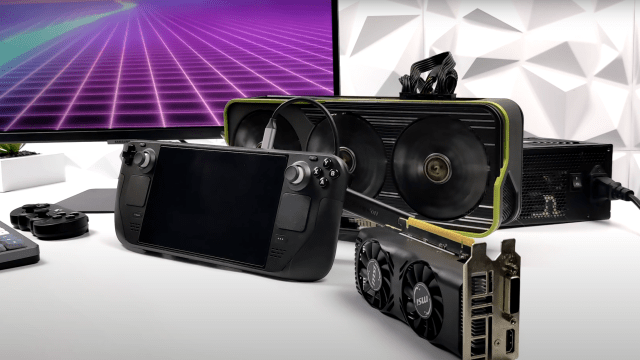Valve has repeatedly insisted that the Steam Deck doesn’t come with external GPU support, shooting down gamer’s hopes of connecting an RTX 3090 and cranking the graphics settings to Ultra. At the same time, Valve keeps emphasising how the Steam Deck is an open platform, a device that can be modified to fit a user’s needs and preferences.
So what does a DIYer do with that info? Listen to the stuff they wanted to hear and ignore the rest, of course. The folks running the ETA Prime YouTube channel found a way to augment the Steam Deck’s custom AMD Zen 2 processor and RDNA 2 graphics with an AMD Radeon RX 6900 XT GPU — a high-end desktop graphics card.
It wasn’t easy, and you shouldn’t try this with your shiny new handheld console, but the hack mostly worked. ETA Prime originally wanted to mod the Steam Deck with an Nvidia GeForce GTX 1650 card, but they discovered that the Steam Deck didn’t play nicely with cards from AMD’s rival.
Since the Steam Deck doesn’t contain a Thunderbolt port (it uses a standard USB-C), ETA Prime had to jerry-rig an M.2 connector with a PCIe x4 interface by swapping the internal SSD with an external dock. They then connected a desktop-grade power supply cube to the GPU to give it the juice the diminutive Steam Deck lacks. As you can imagine, the setup looks silly — you have a Nintendo Switch-like handheld daisy-chained to a massive GPU and a chonky power supply. It’s not the sort of thing you could play on the train during your commute to work.
Since the M.2 slot was being used for the external GPU, a microSD card had to be employed for all OS and game storage. And while ETA Prime would have kept SteamOS 3.0 on the Deck, since Valve’s operating system can’t be booted from a microSD card yet, the mod uses Windows 11 instead.
After booting up Windows, ETA Prime opened Task Manager and discovered that, along with the native AMD APU, the system was running on a Radeon RX 6900 XT external graphics card. It worked! Of course, connecting a full-blown desktop GPU to a handheld console is like placing a turbocharged V8 engine into a Ford Pinto — the other components weren’t designed to accommodate such a powerful card, so bottlenecks are inevitable.
And yet, even with a stunted RX 6900 XT, the Steam Deck quadrupled its performance in synthetic 3DMark benchmarks and played demanding games like The Witcher 3 at 4K resolution on Ultra settings at an average of 108 frames per second. The modded Steam Deck even played GTA V at 4K on Very High at 73 fps and Elden Ring on 1080p at Max setting at 46 fps. Again, the Steam Deck’s RX 6900 XT card was being bottlenecked by its low-power APU and slow storage, but even then, the system saw huge performance gains.
This obviously isn’t the sort of thing you should try with your own system. The Steam Deck wasn’t designed to support external graphics cards, and adding one essentially turns this sleek portable console into a messy (but delightful) stationary desktop. Even ETA Prime cautions against using this method to beef up Valve’s console. So why did they do it? For the best reason: “Because we can.”
